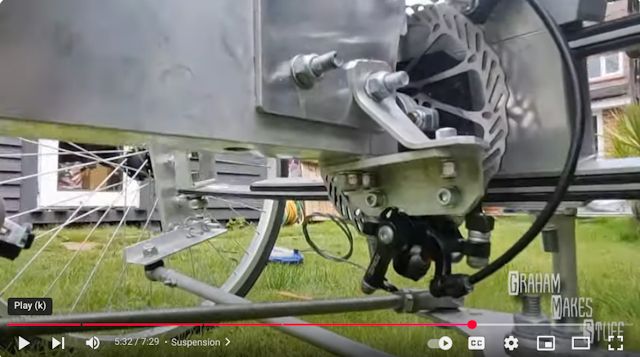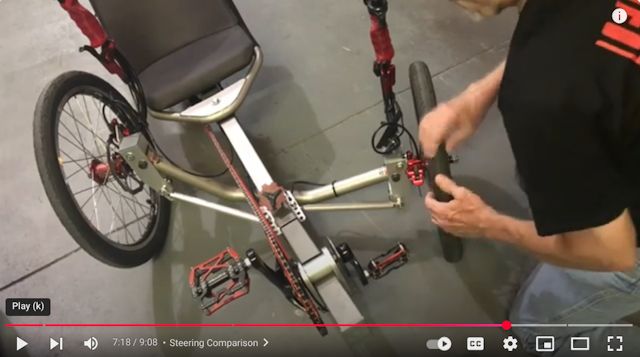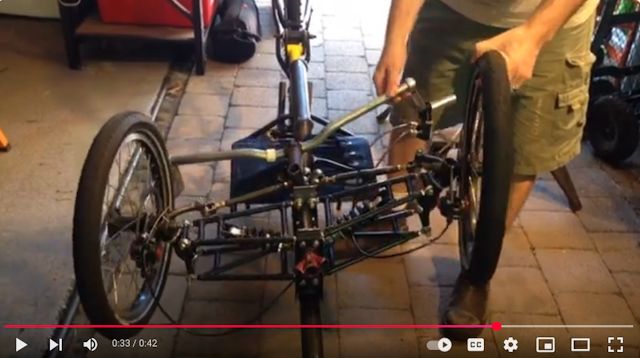Another look at tilting tadpole trike designs
I have started a new project, to build a full-suspension leaning tadpole trike, from scratch. Previous post:
- Planning a recumbent trike built from scratch — February 21, 2025
I have been looking at leaning-trike designs over the last couple of years, and had intended to implement it in the current trike build. But, decided it is too complicated, and ended up with a non-leaning trike. Here is the tilting mechanism that I considered, late in 2023:
- Two-shock design with swinging steering linkage — November 18, 2023
The problem back then, was could not figure out how to connect the tilt mechanism to the steering arms. Have come a long way since then, and now have a design that is simple and looks like it will work. However, taking a bit of a retrospective look, at what others have done and posted on YouTube...
1: Tilting by balance
Most of these are DIY projects. A few guys have built trikes that rely on balance, like you balance on a bicycle. The entire trike, from the rider back to rear wheel, is free to rotate and relies on the rider shifting weight to keep upright. The two front wheels do not rotate, they stay vertical on the ground. In the last couple of blog posts, posted links to "Graham Makes Stuff" YouTube videos; in Part-6, he attempted a leaning mechanism, and went for the balance method. He used a disk brake and caliper, like this:

There is a lever on top that locks the disk, so no tilting. Once underway, the rider releases the lever, then relies on balance, just like a bicycle. However, Graham's experience was that it was very difficult to stop the trike from just falling over.
On a bicycle, the rider is high, making it easy to balance; not so on a recumbent trike. There are a few of these type of designs, including this one, in the "Metal Machine Shop" channel:
https://www.youtube.com/watch?v=NkPyv3-LZmU
...he also experienced balance problems, and has proposed a "MK2" with higher seating. That will help, but is it enough?
2: Tilting hard-linked to the turning arms
What I mean by this, is that the lean is directly linked to how much the rider turns the steering arms. So, turn the steering arms to go left or right in a wide arc, the trike will lean a little bit. Turn to go around a sharp corner, the trike will lean into the corner a lot.
An example of this is the AR3 trike:
https://www.youtube.com/watch?v=t1sUOtY4fYs

Reports from tests are that directly linking leaning to turning
radius is not so good. For example, you might turn the steering to
negotiate a very sharp turn, at very low speed, and the trike will
lean way over into the corner; potentially causing the trike to
topple, especially if the back wheel has luggage above it, causing
a rather high centre of gravity -- that back wheel can drag the
entire trike over.
The AR3 has another problem, that you can see from the photo; despite being tilting, the width has to be wide, as the entire front assembly pivots. This trike actually got to production, but was not a success.
3: Independent turn and tilt control
There have been a few of these type, DIY projects. The one that I am most familiar with, was made by Martin, who lives in Western Australia. That was his "EATSRHPV" trike, about 9 years ago:
"EATSRHPV Tilt mechanism with Steering levers completed"
https://www.youtube.com/watch?v=koADanl4-vo

...He has posted a series of videos showing construction; very complicated, but it does work. The steering arms are swiveled forward and back to turn, or moved left and right to tilt. So, independently controlled.
There are some others posted on YouTube that look like this independent control, though construction details and mechanism close-ups are not shown.
Of these, Number-3 is clearly superior.I have worked out a design for the proposed new trike, that is the same principle as number-3, with the steering arms independently controlling steering and tilting. It is also a very simple design. The plans have already been drawn up on the computer. I keep looking at the plans, wondering if I have missed anything obvious. But, seems OK; full-suspension with correct camber/toe/Ackermann, as well as tilting. Well, we shall see, have parts on order.
EDIT 2025-02-26:
I forgot to mention, there was a Number-2 type that was
manufactured in 2014 and was in production, briefly. It was the
"Wild Wave", made by Stein Trikes. Here is a video:
https://www.youtube.com/watch?v=zFv9jWgSOOc
There isn't much information about it, but
looking at that video, it seems like Number-2, turning and
tilting locked together.
Stein Trikes seems not to have published
reasons why they discontinued it. Google's "Generative AI" does
give reasons, but they are just guesses.
Tags: light
